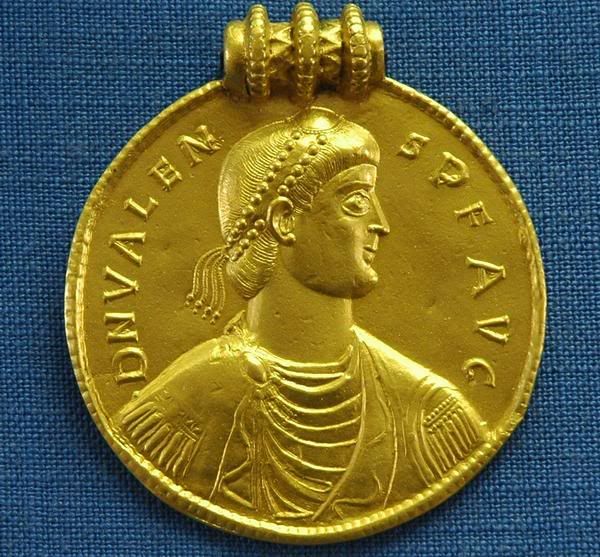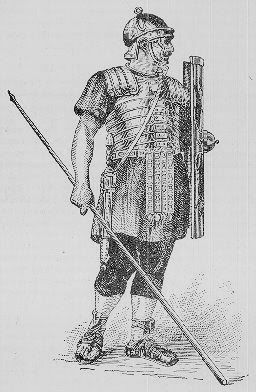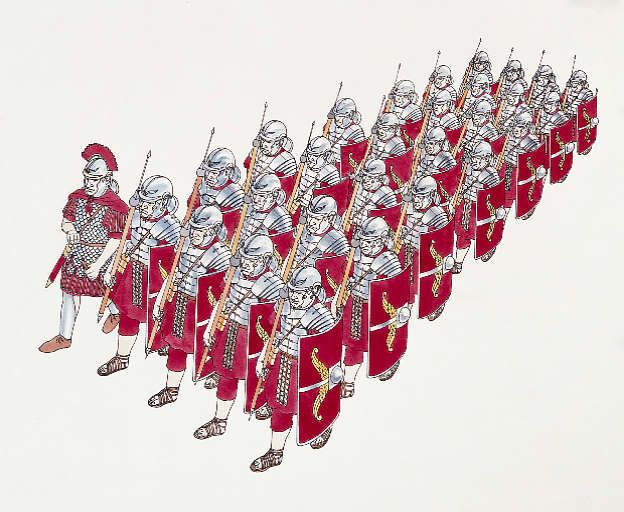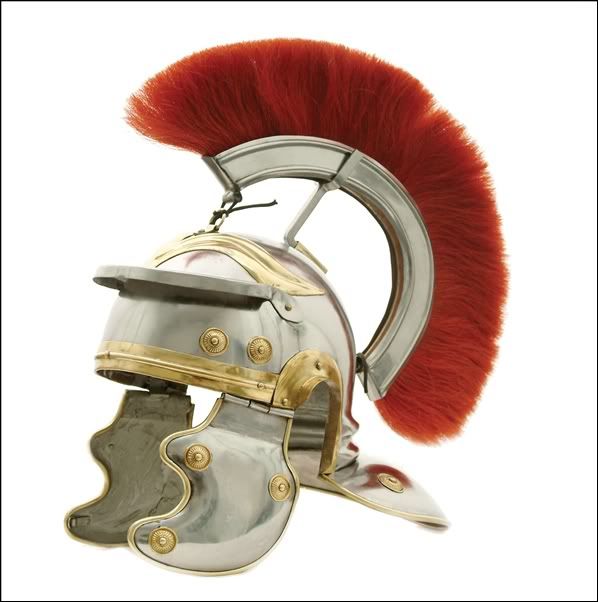 The annals of the later Roman empire are scarred by events that took place near the Thracian city of Adrianople on the afternoon of August 9, ad 378. By that evening, the eastern Roman Emperor Valens was dead along with tens of thousands of irreplaceable warriors, in a defeat that signaled the beginning of the end of Rome’s ability to resist external pressure and prevent penetration of its defenses. According to the contemporary historian Ammianus Marcellinus, himself a Roman officer, “No battle in our history except Cannae [Hannibal Barca’s great victory in 216 bc] involved such a massacre.”
The annals of the later Roman empire are scarred by events that took place near the Thracian city of Adrianople on the afternoon of August 9, ad 378. By that evening, the eastern Roman Emperor Valens was dead along with tens of thousands of irreplaceable warriors, in a defeat that signaled the beginning of the end of Rome’s ability to resist external pressure and prevent penetration of its defenses. According to the contemporary historian Ammianus Marcellinus, himself a Roman officer, “No battle in our history except Cannae [Hannibal Barca’s great victory in 216 bc] involved such a massacre.” After the death of Emperor Constantine in ad 337, the Roman empire saw the return of sibling struggles for total control. Constantine had hoped that his three surviving sons would be satisfied with one-third of the empire each—Flavius Julius Constans in western Europe, Constantine II in southeastern Europe and Constantius II the eastern provinces—but such was not to be. Constantine II was killed in Italy in 340; Constans was overthrown by the usurper Magentius and slain by Gaiso while fleeing to Iberia in January 350. Then Constantius, while moving to deal with a revolt by his cousin, General Flavius Claudius Julianus, died of a fever in Cilicia on November 3, 361. With the death of all three of Constantine I’s direct heirs, Rome was ruled by a succession of army generals.
The general who finally secured the imperial purple on February 26, 364, was Flavius Valentinianus, a man of humble birth but considerable military skill. As Emperor Valentinian I, he focused on shoring up the frontier along the Danube River. To keep the eastern part of the empire in friendly hands, on March 28 Valentinian appointed his brother, Flavius Julius Valens, to the position of co-emperor and placed him in Constantinople. Valentinian died in 375 and was succeeded by his 16-year-old son, Flavius Gratianus, or Gratian. Contemporaries described Gratian as “a young man of remarkable talent: eloquent, controlled, warlike, yet merciful.” During his short life, he fought successfully against Rome’s enemies and vigorously attacked the last vestiges of paganism. At the time he became emperor in the west, however, Gratian was much too inexperienced to hold any sway over his uncle, Valens.
In contrast to his brother, Valens did not join the Roman army until 360. Nevertheless, he conducted an offensive campaign against the Goths, from 367 to 369, with vigor and skill. In spite of difficulties in carrying out operations against elusive enemies in their home territory, he was able to bring his Goth foes to battle and defeat them.
conducted an offensive campaign against the Goths, from 367 to 369, with vigor and skill. In spite of difficulties in carrying out operations against elusive enemies in their home territory, he was able to bring his Goth foes to battle and defeat them.
According to their own traditions, the Goths originated in a land called Gothiscandza, identified as southern Scandinavia. Those same traditions cite population pressure as the reason for their move to what would become their long-standing homeland between the Oder and Vistula rivers, in what is now Poland. However, no archaeological evidence exists to support this idea. What seems to have happened was a slow, steady drift from the Oder-Vistula region into Scythia, now known as Ukraine. That region already contained a mixed population, and the Goths would certainly have mixed with other peoples to produce a populace that was far from homogeneous. By the middle of the 3rd century, they had become a formidable power.
The leader of a Visigoth tribe called the Tervingians, Fritigern (derived from the Goth word frithugairns, “desiring peace”) was a prominent warrior-king whose followers included a number of Roman subjects as well as Goths. The former ranged from escaped slaves and gold miners to Goth soldiers in the Roman army who, although initially loyal to Rome, had been driven to rebellion by the hostility of the local populace. Fritigern must have been a man of enormous charisma and strength of will. He managed to hold together a confederacy of disparate clans and tribes with no greater authority than their belief in his ability to win. Since Fritigern’s followers included Huns, Roman expatriates and Germanic tribesmen, many would have deserted him had they felt better off under someone else’s leadership.
Compared to the vast trove of information available on the Roman army of the 4th century, virtually nothing is known of the Goth fighting organization—if there was one. Nevertheless, the Goths were not mere wild men, as popularly portrayed in Roman and later accounts. Many had served in Roman armies and knew how to wield a sword, spear or battle-ax with skill. Such weapons were more of a threat to the Romans than in previous centuries due to changes in the Roman infantry. Because of reductions in available funds for military spending, the Roman soldier wore less metal armor, his shield was smaller and rounder and, to compensate, his short stabbing gladius had been replaced by a sword longer than the one he had used in the 1st century. Roman infantry formations were still formidable but had lost some of the invincible aura they had enjoyed in the imperial heyday.
 The Goths often fought from a laager, a group of wagons arranged in a circle, from which they would dart out to do battle, then quickly return. This amounted to a mobile fortress that could protect them no matter where they fought.
The Goths often fought from a laager, a group of wagons arranged in a circle, from which they would dart out to do battle, then quickly return. This amounted to a mobile fortress that could protect them no matter where they fought.
In the fall of 376, the Romans agreed to help Fritigern’s people cross the Danube and settle in the province of Moesia. In 377, however, a famine struck the Roman areas settled by the Visigoths, and their appeals for help went unanswered by the Roman authorities. The magister militum (governor-general) of the area, Lupicinus, and his dux secundae, Magnus Maximus, treated the Visigoths badly, forcing them to pay exorbitant prices for food and keeping Goth women as concubines.
As the Goths became restive, Lupicinus invited Fritigern, Alaviv and other Visigoth chieftains to a banquet at his headquarters in Marcianople, planning to make them hostages to keep their tribes in line. His plan failed—a fight broke out and the Romans killed Gothic escorts and Alaviv, but Fritigern managed to fight his way out of the trap.
The Tervingians under Fritigern now rose in open revolt, pillaging the countryside surrounding Marcianople. Lupicinus led a small force to confront them nine miles outside the city, only to be overpowered and massacred.
The crisis continued into 378, with the Visigoths holding sway over much of Thrace, an ancient country in the southeastern part of the Balkan Peninsula, reaching north to the Danube and comprising modern Bulgaria and parts of Greece and Turkey.
Emperor Valens and his army were in Thrace, marching west from Adrianople along the Martisa River valley, when news reached him that the Goths were moving south along the Tundzha River. At first he thought it was only a small raiding party, but he soon realized it was a much larger force. He therefore turned back toward Adrianople and established a fortified camp just outside the city.
Located at the western end of the Thracian plain near the Greek border, 130 miles northwest of Constantinople, Adrianople (now Edirne in Turkey) was originally named Hadrianopolis, for the Roman Emperor Hadrian, who built it in ad 125 on the site of the ancient city of Uskudarna. Lying at the confluence of the Martisa, Tundzha and Arda rivers, it had been of geographic and military importance since ancient times.
Holding a conference with his lieutenants during the night of August 8, 378, Valens faced a crucial decision: Should he engage the Goths at once or wait for his young nephew and co-emperor, Gratian, to join him? This question resulted in a rift among his senior officers. The more cautious among them recommended that Valens wait and allow Gratian to arrive with his army. The Romans could then move as a combined force to fight a stronger battle and wipe out the entire Goth threat. Gratian’s western contingent was not many days’ march away, they argued, and communications between the two armies had already been established.
decision: Should he engage the Goths at once or wait for his young nephew and co-emperor, Gratian, to join him? This question resulted in a rift among his senior officers. The more cautious among them recommended that Valens wait and allow Gratian to arrive with his army. The Romans could then move as a combined force to fight a stronger battle and wipe out the entire Goth threat. Gratian’s western contingent was not many days’ march away, they argued, and communications between the two armies had already been established.
Another group of officers, led by a general who knew what he was doing, urged immediate action. Comes (Count) Sebastianus had been appointed to overall command in the region two months earlier, and in the previous weeks had adopted an aggressive guerrilla-style mode of campaigning. It had proved immensely successful thus far, forcing the Goths to cease raiding in small bands and coalesce into much larger groups for their own protection. That made them vulnerable to a conventional, large-scale Roman attack. Sebastianus had, in fact, caught and destroyed a large column of Goths returning from a plundering expedition to Rhodope in southern Thrace, shortly before joining Valens and being appointed to command his infantry.
Several factors influenced Valens’ final decision. First, his scouts reported that the Goth force contained only about 10,000 fighting men. Since Valens had about 15,000 soldiers in his own army, it was tempting to engage the Goths in battle then and there. Moreover, Valens’ standing in Constantinople was very low at that time. If he allowed a Goth army to take position between Adrianople and Constantinople, he would not only find his supply lines cut off but also risk the likelihood that the populace in the eastern capital would feel abandoned by their emperor.
Valens’ contemporary, Ammianus, and many later historians believed that the emperor—jealous of his young nephew—decided on an immediate battle to gain personal glory. Though that was perhaps true, it would not have been the only reason for Valens’ hasty actions. He might have underestimated the Goths’ strength, for he had defeated them on the Danube nine years earlier. In any case, Valens seemed confident of an easy victory on the morning of August 9 as he led the field army of the east from Adrianople to attack the Goths, who were camped 12 miles from the city.
The Romans marched rapidly under a blazing sun, coming upon the Goth camp at about 2 that afternoon. The Goths were encamped in a secure position, probably on high and easily defensible ground. The imperial troops were hastily drawn up into battle formation while the Goths broke into savage howls, as they were accustomed to do just before an engagement.
Either because of unfamiliarity with the terrain or by mistake, the right wing of the Roman cavalry came within sight of the Goths while the left was still a considerable distance away, with many of the horsemen on the left wing scattered along roads leading up to the Goth camp. Some historians assume that the Goths fought from behind their wagon laager at Adrianople, but that would have been unlikely. Their usual procedure was to engage their enemies in the open and fall back on the camp only when an encounter was not going well. Had they remained behind the laager, they would not only have surrendered the initiative to the Romans but also would have been unable to use their preferred fighting tactic of charging into hand-to-hand combat with spears, swords and shields. On several occasions Ammianus’ descriptions of the battle explain that one part of the Roman line managed to fight its way forward as far as the wagons, clearly indicating that the fighting took place primarily in the open, beyond the wagon laager.
Riding boldly into the Roman right wing, the Goth cavalry scattered the surprised Roman cavalry line and then turned to attack the Roman left wing. Within moments, all the Roman horsemen had been driven from the field, leaving the weary infantry exposed.
Fritigern chose that moment to burst from the laager at the head of his own infantry. Ammianus described the Roman soldiers’ plight: “The different companies became so huddled together that hardly anyone could pull out his sword, or draw back his arm, and because of immense clouds of dust, the heavens could no longer be seen….Hence Goth arrows whirling death from every side found their mark with fatal effect, since they could not be seen beforehand nor guarded against.”
described the Roman soldiers’ plight: “The different companies became so huddled together that hardly anyone could pull out his sword, or draw back his arm, and because of immense clouds of dust, the heavens could no longer be seen….Hence Goth arrows whirling death from every side found their mark with fatal effect, since they could not be seen beforehand nor guarded against.”
Hemmed in from all sides, the Roman foot was packed together too tightly to create any effective battle formation. The slaughter was frightful as Fritigern’s infantry closed in, while his cavalry kept any Romans who broke out from getting very far. The battlefield ran red with blood, most of it Roman. Men slipped on the bloody ground, and many died after falling on their own weapons. Heaps of bodies littered the field, including that of Comes Sebastianus.
There are two stories concerning Valens’ fate. One claims that an arrow struck him while he was among the ranks of his army, and his body was never found. The other claims that, wounded by an arrow, he was taken by his guards to a nearby peasant dwelling, which the Goths subsequently attacked. The Roman defenders initially managed to drive back the Goths with arrows, but they soon returned, piled up brushwood and straw against the house and set fire to it. One Roman soldier jumped from a window and was captured by the Goths, but the others, including the emperor, perished in the blaze. The prisoner later escaped to tell the story.
Ammianus stated that two-thirds of the Roman army died at Adrianople. His comparison of the massacre to Hannibal Barca’s tactical masterpiece at Cannae is apt because in both battles Roman horsemen were driven from the field, leaving the infantry to be encircled, hemmed in and destroyed.
The outcome at Adrianople shocked the Western world. The Romans had lost battles before, but never so decisively. Nor had barbarians made Roman commanders look so utterly incompetent at the art of war. From beginning to end, Valens and his generals had been outguessed, outsmarted and outmaneuvered by Fritigern’s Goths.
Various explanations have been offered for this improbable victory by an ad hoc force of refugees and deserters over the best-organized, best-equipped and best-disciplined army in the world. Some observers claimed that, contrary to Valens’ faulty appraisal, the Goths enjoyed a numerical superiority of as many as 200,000 warriors. In fact, given the logistical difficulties of feeding and sustaining so many men, Fritigern would have been lucky to muster one-tenth that number. Other historians claimed that the battle proved the superiority of cavalry over infantry. The truth is that while a timely cavalry charge sealed the battle’s ultimate outcome, it was primarily a clash of infantry with infantry.
The Roman defeat at Adrianople can be attributed to both strategic and tactical reasons. At the strategic level, the Romans were unable to assemble enough high-quality troops to deal rapidly and decisively with the Goth threat. Although the empire had some 500,000 men under arms at that time, they were committed to guarding imperial borders from Britannia to Syria. There was a real danger that if a significant number was moved from one point to another, a potential enemy would take advantage of the weakened border segment to attack. Moreover, while Roman field armies were supposedly mobile and rapidly deployable, orders to move to a new area of operations often resulted in mass desertions that critically thinned their ranks.
When it came to using the force at their disposal, the Roman commanders at Adrianople acted with an arrogance typical of leaders of a well-equipped “civilized” army faced with what they perceived as rabble. Those commanders allowed themselves to be drawn into battle without proper reconnaissance and without ensuring that the odds were stacked in their favor before committing their forces to a fight.
 It is also probable that the quality and morale of eastern Roman soldiers were low before the campaign began. Only 13 years earlier, Valens had led them on a rigorous but reasonably successful campaign against the Sassanian Persians, only to abandon the effort and leave Armenia in Persian hands. In any case, it was an overwhelmingly hot August day when Valens’ soldiers marched hurriedly from Adrianople to the plain near where the Goths had been reported. Consequently, they were exhausted and thirsty before the fighting began. It would be unjust, however, to cite the Roman failings without crediting the strategic skill shown by Fritigern; in spite of his logistic problems, the Goth commander managed to dictate the terms and tempo throughout the campaign.
It is also probable that the quality and morale of eastern Roman soldiers were low before the campaign began. Only 13 years earlier, Valens had led them on a rigorous but reasonably successful campaign against the Sassanian Persians, only to abandon the effort and leave Armenia in Persian hands. In any case, it was an overwhelmingly hot August day when Valens’ soldiers marched hurriedly from Adrianople to the plain near where the Goths had been reported. Consequently, they were exhausted and thirsty before the fighting began. It would be unjust, however, to cite the Roman failings without crediting the strategic skill shown by Fritigern; in spite of his logistic problems, the Goth commander managed to dictate the terms and tempo throughout the campaign.
Gratian was well advanced in his march to assist Valens at Adrianople when he learned that his impatient co-emperor had been killed and most of his army destroyed. In light of this setback and distracted by his own affairs in the western empire, he believed that imperial administration in the east would require undivided attention that he would be unable to give. Gratian therefore placed Flavius Theodosius, the son of a distinguished general and himself a commander of some experience, in charge. On January 19, 379, Theodosius was proclaimed co-emperor and officially assigned to rule the eastern provinces.
Fritigern’s victory at Adrianople gave the Goths control of nearly the entire Balkan Peninsula. They raided Greece, leaving only the city of Athens and other small areas of that country unravaged.
Theodosius’ plan for pacifying the Goths proved to be as damaging as Valens’ original decision to let them cross the Danube. He would grant them the right to occupy Thrace if they would swear loyalty to the empire and become Roman soldiers. Peace was restored, but at a tremendous cost. With the empire lacking the human resources to replace its losses in the wake of Adrianople, the Roman army was transformed into an army of Goths fighting for the emperor. As the 4th century ended, the Goths bloodlessly gained control of the army. For the first time in its history, the Roman army was no longer composed primarily of Romans.
Scholars have given a variety of dates for the fall of Rome, the latest being 1453, when Constantinople, capital of the eastern Roman empire, fell to the Ottoman Turks, but that was a new, Byzantine, Greek-speaking empire far removed from the Caesars. The fall of the western empire is set at 476, when its last emperor, Romulus Augustulus, surrendered to the Ostrogoths. That, however, was just the coup de grâce following a succession of disasters, such as the murder of Valentinian III in 455, the loss of the African provinces to the Vandals in 429 and Alaric’s sack of Rome in 410.
Constantinople, capital of the eastern Roman empire, fell to the Ottoman Turks, but that was a new, Byzantine, Greek-speaking empire far removed from the Caesars. The fall of the western empire is set at 476, when its last emperor, Romulus Augustulus, surrendered to the Ostrogoths. That, however, was just the coup de grâce following a succession of disasters, such as the murder of Valentinian III in 455, the loss of the African provinces to the Vandals in 429 and Alaric’s sack of Rome in 410.
It might be argued that ancient Rome received its mortal blow in 378, and simply took almost a century to die. The empire had been in bad shape before, but not so bad that a single strong leader could not have saved the situation. After Adrianople, however, Rome’s decline became irreversible. Once the Romans had to rely on the Goths to fight their wars for them, the emperor’s power collapsed, and the new Goth-dominated army was unable to fend off other marauding peoples who spilled over the eastern frontiers.
It may be stretching the point for military historians to pronounce Adrianople a victory of cavalry over infantry that ushered in the era of the medieval knight. After that battle, however, Roman armies lost their classical character. Cavalry came to predominate, and because horsemen, especially those from the East, were also archers, their ability to attack at long range severely limited the power of infantry formations. Not until the 15th century did weapons such as the longbow and crossbow begin to overturn the effectiveness of cavalry on the battlefield.
As the reliability of the native Roman army declined after Adrianople, emperors, generals and even private citizens began to hire bands of retainers, usually Germanic in make?up. By the mid-5th century, Roman field armies had evolved into large bands of mounted warriors owing their allegiance directly to powerful warlords rather than to the state. Those armies had more in common with a feudal host than with Rome’s republican or imperial legions of classical times.
 Although it was fought in the East, the Battle of Adrianople had its most direct effect on the affairs of Rome’s western provinces. It initiated a huge influx of Germanic peoples who continued their migrations to overrun the western Roman empire within the next century. In ironic contrast, the eastern Roman empire, with its capital at Constantinople, would survive the fall of Rome itself and, adapting to the eastern environment in which it was isolated amid a sea of barbarians, endure for another 1,000 years.
Although it was fought in the East, the Battle of Adrianople had its most direct effect on the affairs of Rome’s western provinces. It initiated a huge influx of Germanic peoples who continued their migrations to overrun the western Roman empire within the next century. In ironic contrast, the eastern Roman empire, with its capital at Constantinople, would survive the fall of Rome itself and, adapting to the eastern environment in which it was isolated amid a sea of barbarians, endure for another 1,000 years.
For further reading, Cary, N.C.?based contributor Joe Zentner recommends: Adrianople ad 378: The Goths Crush Rome’s Legions, by Simon MacDowall; and Barbarians, by Tim Newark.
Watch the Battle of Adrianople at






























































Δεν υπάρχουν σχόλια:
Δημοσίευση σχολίου